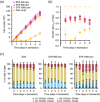Expansion and differentiation of ex vivo cultured erythroblasts in scalable stirred bioreactors
- PMID: 35879812
- PMCID: PMC9804173
- DOI: 10.1002/bit.28193
Expansion and differentiation of ex vivo cultured erythroblasts in scalable stirred bioreactors
Abstract
Transfusion of donor-derived red blood cells (RBCs) is the most common form of cell therapy. Production of transfusion-ready cultured RBCs (cRBCs) is a promising replacement for the current, fully donor-dependent therapy. A single transfusion unit, however, contains 2 × 1012 RBC, which requires large scale production. Here, we report on the scale-up of cRBC production from static cultures of erythroblasts to 3 L stirred tank bioreactors, and identify the effect of operating conditions on the efficiency of the process. Oxygen requirement of proliferating erythroblasts (0.55-2.01 pg/cell/h) required sparging of air to maintain the dissolved oxygen concentration at the tested setpoint (2.88 mg O2 /L). Erythroblasts could be cultured at dissolved oxygen concentrations as low as 0.7 O2 mg/ml without negative impact on proliferation, viability or differentiation dynamics. Stirring speeds of up to 600 rpm supported erythroblast proliferation, while 1800 rpm led to a transient halt in growth and accelerated differentiation followed by a recovery after 5 days of culture. Erythroblasts differentiated in bioreactors, with final enucleation levels and hemoglobin content similar to parallel cultures under static conditions.
Keywords: cell culture; cultured blood; erythropoiesis; red blood cell; scale-up; stirred tank bioreactor.
© 2022 The Authors. Biotechnology and Bioengineering published by Wiley Periodicals LLC.
Conflict of interest statement
The authors declare no conflict of interest.
Figures






Similar articles
-
The productivity limit of manufacturing blood cell therapy in scalable stirred bioreactors.J Tissue Eng Regen Med. 2018 Jan;12(1):e368-e378. doi: 10.1002/term.2337. Epub 2017 Apr 3. J Tissue Eng Regen Med. 2018. PMID: 27696710 Free PMC article.
-
Red cell manufacturing using parallel stirred-tank bioreactors at the final stages of differentiation enhances reticulocyte maturation.Biotechnol Bioeng. 2021 May;118(5):1763-1778. doi: 10.1002/bit.27691. Epub 2021 Feb 2. Biotechnol Bioeng. 2021. PMID: 33491764
-
An Optimized Human Erythroblast Differentiation System Reveals Cholesterol-Dependency of Robust Production of Cultured Red Blood Cells Ex Vivo.Adv Sci (Weinh). 2024 Jun;11(22):e2303471. doi: 10.1002/advs.202303471. Epub 2024 Mar 13. Adv Sci (Weinh). 2024. PMID: 38481061 Free PMC article.
-
Bioreactor scale-up and oxygen transfer rate in microbial processes: an overview.Biotechnol Adv. 2009 Mar-Apr;27(2):153-76. doi: 10.1016/j.biotechadv.2008.10.006. Epub 2008 Nov 12. Biotechnol Adv. 2009. PMID: 19041387 Review.
-
Current status of red blood cell manufacturing in 3D culture and bioreactors.Blood Res. 2023 Apr 30;58(S1):S46-S51. doi: 10.5045/br.2023.2023008. Epub 2023 Apr 7. Blood Res. 2023. PMID: 37026380 Free PMC article. Review.
Cited by
-
Sodium-Selective Channelrhodopsins.Cells. 2024 Nov 8;13(22):1852. doi: 10.3390/cells13221852. Cells. 2024. PMID: 39594600 Free PMC article. Review.
-
Generation of red blood cells from induced pluripotent stem cells.Curr Opin Hematol. 2024 May 1;31(3):115-121. doi: 10.1097/MOH.0000000000000810. Epub 2024 Feb 13. Curr Opin Hematol. 2024. PMID: 38362913 Free PMC article. Review.
-
Generation of red blood cells from stem cells: Achievements, opportunities and perspectives for malaria research.Front Cell Infect Microbiol. 2022 Nov 14;12:1039520. doi: 10.3389/fcimb.2022.1039520. eCollection 2022. Front Cell Infect Microbiol. 2022. PMID: 36452302 Free PMC article. Review.
-
Differentiating erythroblasts adapt to mechanical stimulation by upregulation of cholesterol biosynthesis via S1P/SREBP-induced HMGCR expression.Sci Rep. 2024 Dec 4;14(1):30157. doi: 10.1038/s41598-024-81746-8. Sci Rep. 2024. PMID: 39627481 Free PMC article.
-
Baffled-flow culture system enables the mass production of megakaryocytes from human embryonic stem cells by enhancing mitochondrial function.Cell Prolif. 2023 Dec;56(12):e13484. doi: 10.1111/cpr.13484. Epub 2023 Apr 23. Cell Prolif. 2023. PMID: 37088551 Free PMC article.
References
-
- Aglialoro, F. , Abay, A. , Yagci, N. , Rab, M. A. E. , Kaestner, L. , van Wijk, R. , von Lindern, M. , & van den Akker, E. (2021). Mechanical stress induces Ca2+‐dependent signal transduction in erythroblasts and modulates erythropoiesis. International Journal of Molecular Sciences, 22(2), 935. 10.3390/ijms22020955 - DOI - PMC - PubMed
-
- Al‐Masry, W. A. (1999). Effects of antifoam and scale‐up on operation of bioreactors. Chemical Engineering and Processing: Process Intensification, 38(3), 197–201. 10.1016/S0255-2701(99)00014-8 - DOI
Publication types
MeSH terms
Substances
LinkOut - more resources
Full Text Sources

